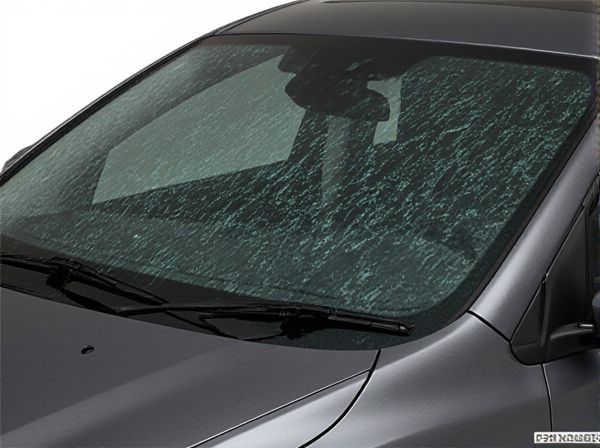
Photo illustration: Rain-Sensing Windshield vs Conventional Windshield
Rain-sensing windshields automatically detect moisture and activate the wipers, providing enhanced safety and convenience compared to conventional windshields, which require manual wiper operation. This technology improves visibility during sudden weather changes, reducing driver distraction and reaction time. Your driving experience becomes safer and more comfortable, especially in unpredictable rain conditions.
Table of Comparison
| Feature | Rain-Sensing Windshield | Conventional Windshield |
|---|---|---|
| Automatic Wiper Activation | Yes, detects rain intensity and activates wipers automatically | No, manual control required |
| Safety | Enhanced visibility during rain, reduces driver distraction | Driver must manually adjust wipers, potential distraction |
| Technology | Integrated rain sensor embedded in windshield | Standard laminated glass without sensors |
| Cost | Higher initial cost due to sensor technology | Lower upfront cost |
| Maintenance | Requires sensor calibration and cleaning | Minimal, mostly glass cleaning |
| Convenience | Hands-free operation improves driving comfort | Manual operation needed, less convenient |
Introduction to Windshield Technologies
Rain-sensing windshields integrate advanced rain detection sensors that automatically activate and adjust windshield wiper speed based on moisture levels, enhancing driver visibility and safety. Conventional windshields rely solely on manual wiper controls, requiring driver intervention to manage visibility during precipitation. These innovations in windshield technology demonstrate ongoing efforts to improve driving convenience and responsiveness in varying weather conditions.
What is a Rain-Sensing Windshield?
A rain-sensing windshield is equipped with advanced sensors that detect moisture and automatically activate the windshield wipers, enhancing driver convenience and safety during wet conditions. Unlike conventional windshields that require manual wiper operation, rain-sensing windshields use optical sensors to monitor rain intensity and adjust wiper speed accordingly. This technology improves visibility without driver intervention, reducing distractions and optimizing response time in changing weather.
How Conventional Windshields Operate
Conventional windshields rely solely on manual wiper controls operated by the driver to clear rain, requiring constant attention and adjustment for varying weather conditions. These windshields lack integrated sensors, making them less efficient during sudden or light rainfalls, potentially compromising visibility. The absence of automated response systems means that drivers must anticipate weather changes and activate wipers themselves, increasing the risk of delayed reaction during critical moments.
Key Differences Between Rain-Sensing and Conventional Windshields
Rain-sensing windshields utilize embedded sensors that automatically detect moisture levels and activate windshield wipers accordingly, enhancing driving safety and convenience during rainy conditions. Conventional windshields lack this technology, requiring manual adjustment of wiper speed and frequency, which may lead to delayed response times and reduced visibility. The integration of rain sensors in rain-sensing windshields results in more efficient water removal and improved driver focus compared to traditional manual wiper control systems.
Advantages of Rain-Sensing Windshields
Rain-sensing windshields enhance driving safety and convenience by automatically activating wipers when moisture is detected, allowing drivers to maintain focus without manual adjustments. These advanced sensors optimize visibility in varying weather conditions, reducing distraction and improving reaction times. Compared to conventional windshields, they deliver superior responsiveness, lower wear on wiper blades, and increased overall driving comfort.
Benefits of Conventional Windshields
Conventional windshields offer consistent clarity and visibility without reliance on sensors or electronic systems, ensuring reliable performance in all weather conditions. They require less maintenance and have lower repair costs compared to rain-sensing windshields, making them cost-effective for vehicle owners. Their straightforward design minimizes the risk of malfunctions, providing dependable protection against wind, debris, and harsh elements.
Cost Comparison: Rain-Sensing vs Conventional
Rain-sensing windshields typically cost 20% to 40% more than conventional windshields due to the embedded sensors and advanced technology. Replacement expenses for rain-sensing windshields range from $400 to $700, whereas conventional windshield replacements usually fall between $200 and $400. Insurance premiums may also be higher for vehicles equipped with rain-sensing systems because of the increased repair and replacement costs.
Maintenance and Durability Considerations
Rain-sensing windshields require specialized maintenance to ensure the sensors remain unobstructed and calibrated, as dirt or damage can impair automatic wiper functionality. Conventional windshields, while simpler, primarily need regular cleaning and prompt chip repair to maintain visibility and structural integrity. Durability in rain-sensing windshields depends on the sensor technology's resilience, which can be more sensitive to environmental wear compared to the more robust construction of standard windshields.
Safety and Driving Experience
Rain-sensing windshields enhance safety by automatically activating wipers based on moisture detection, reducing driver distraction and improving visibility during sudden rain showers compared to conventional windshields. This technology adapts wiper speed to rainfall intensity, ensuring consistent clarity without manual adjustment, which fosters a smoother and more focused driving experience. Conventional windshields rely on manual wiper control, potentially delaying response time and compromising safety in rapidly changing weather conditions.
Which Windshield Is Right for You?
Rain-sensing windshields automatically detect moisture and activate the wipers, providing enhanced safety and convenience during adverse weather conditions. Conventional windshields require manual adjustment of wiper speed, offering a more affordable option but lacking adaptive responsiveness. Choosing the right windshield depends on your driving habits, budget, and preference for technological convenience versus simplicity.
 caratoz.com
caratoz.com